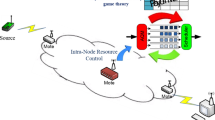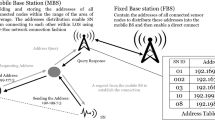Abstract
A wireless sensor networks (WSNs) is composed of small sensors with limited capabilities that are densely distributed in the area. WSNs are subject to more packet loss and congestion. To alleviate congestion, either the source transmission rate should be controlled or the available resources have to be increased. A precision resource control mechanism is necessary to possess an efficient and accurate congestion control. Evolutionary game theory is very useful on the design of large-scale wireless networks. Evolutionary games in large systems provide a simple framework for describing strategic interactions among large number of players. In this paper, we propose an evolutionary game theoretical resource control protocol (EGRC) for wireless sensor networks. EGRC applies evolutionary games to develop a non-cooperative game containing large number of sensors as players for alleviating and controlling congestion in wireless sensor network by utilizing the available resource and controlling radio transmission power. The proposed protocol adjusts the transmission power based on the available energy capacity and node congestion level. Simulation results show the performance of the proposed protocol that improves system throughput, and decreases packet dropping, while saving energy.









Similar content being viewed by others
References
Sohraby, K., Minoli, D., & Znati, T. (2007). Wireless sensor network: Technology, protocols, and applications. New York: Wiley.
Karl, H., & Willig, A. (2005). Protocols and architectures for wireless sensor networks. New York: Wiley.
Kang, J., Zhang, Y., & Nath, B. (2006). Analysis of resource increase and decrease algorithm in wireless sensor networks. In Proceedings of the 11th (ISCC’06), pp. 585–590.
Kang, J., Zhang, Y., & Nath, B. (2007). TARA: Topology-aware resource adaptation to alleviate congestion in sensor networks. IEEE Transactions on Parallel and Distributed Systems, 18(7), 919–931.
Leino, J. (2003). Applications of game theory in ad hoc networks. Master’s thesis, Helisnki University of Technology.
Hofbauer, J., & Sigmund, K. (2003). Evolutionary game dynamics. Journal of Bulletin of the American Mathematical Society, 40(4), 479–519.
Wang, C., Sohraby, K., Daneshmand, M., & Hu, Y. (2007). Upstream congestion control in wireless sensor networks through cross-layer optimization. IEEE Journal on Selected Areas in Communications, 25(4), 786–795.
Ee, C.-T., & Bajcsy, R. (2004). Congestion control and fairness for many-to one routing in sensor networks. In Proceedings of the 2nd international conference on embedded networked sensor systems ACM
Yaghmaee, M. H., & Adjeroh, D. (2009). Priority-based rate control for service differentiation and congestion control in wireless multimedia sensor networks. Journal of Elsevier Computer Networks, 53, 1798–1811.
Wang, C., Sohraby, K., & Li, B. (2005). SenTCP: A hop-by-hopcongestion control protocol for wireless sensor networks. In Proceedings of theIEEE INFOCOM.
Paek, J., & Govindan, R. (2007). RCRT: Rate-controlled reliable transport for wireless sensor networks. In Proceedings of the ACM conference on embedded networked sensor systems (Sensys).
Yaghmaee, M. H., & Adjeroh, D. (2010). A novel congestion control protocol for vital signs monitoring in wireless biomedical sensor networks. In Proceedings of the WCNC conference, pp. 1–6.
Misra, S., Tiwari, V., & Obaidat, M. S. (2009). LACAS: Learning automata-based congestion avoidance scheme for healthcare wireless sensor networks. IEEE Journal on Selected Areas in Communications, 27(4), 466–479.
Farzaneh, N., & Yaghmaee, M.H. (2011). Joint active queue management and congestion control protocol for healthcare applications in wireless body sensor networks. In Proceedings of the 9th international conference on smart homes and health telematics (ICOST). doi:10.1007/978-3-642-21535-3_12
Farzaneh, N., Yaghmaee, M. H., & Adjeroh, D. (2012). An adaptive congestion alleviating protocol for healthcare applications in wireless body sensor networks: Learning automata approach. AmirKabir Journal of Science and Technology, 44(1), 31–41.
Alam, M., & Hong, S. (2009). CRRT: Congestion-aware and rate-controlled reliable transport in wireless sensor networks. IEICE Transactions on Communications, 92(1), 184–189.
Farzaneh, N., & Yaghmaee, M. H. (2013). A prioritization based congestion control protocol for healthcare monitoring application in wireless sensor networks. Wireless Personal Communications, 72(4), 2605–2631.
Fang, W., Chen, J., Shu, L., Chu, T., & Qian, D. (2010). Congestion avoidance, detection and alleviation in wireless sensor networks. Journal of Zhejiang University, 11(1), 63–73.
Wan, A. Y., EisenmanSh, B., & Campbell, A. (2005). Siphon: Overload traffic management using multi-radio virtual sinks in sensor networks. Sensor Systems, 2005, 116–129.
Wan, A. Y., EisenmanSh, B., Campbell, A., & Jon Crowcroft, J. (2007). Overload traffic management for sensor networks. ACM Transactions on Sensor Networks, 3(4), 18.
Kang, J., Zhang, Y., & Nath, B. (2009). An optimal resource control scheme under fidelity and energy constraints in sensor networks. Journal of Wireless Networks, 15, 497–512.
Teo, T., Ha, Y., & Tham, Ch. (2008). Interference-minimized multipath routing with congestion control in wireless sensor network for high-rate streaming. Mobile Computing (IEEE Transactions), 7, 1124–1137.
Seon, C. H., & Lee, S. (2010). Autonomous traffic engineering for boosting application fidelity. IEICE Transactions, 93, 2990–3003.
Ren, F., He, T., Das, S. K., & Lin, C. H. (2011). Traffic-aware dynamic routing to alleviate congestion in wireless sensor networks. Parallel and Distributed Systems, 22, 1585–1599.
Rezaee, A. A., Yaghmaee, M. H., Rahmani, A. M., & Mohajerzadeh, A. H. (2013). HOCA: Healthcare aware optimized congestion avoidance and control protocol for wireless sensor networks. Journal of Network and Computer Applications, 37, 216–228.
Menasche, D. S., Figueiredo, D. R., & de Souza e Silva, E. (2005). An evolutionary game-theoretic approach to congestion control. Performance Evaluation, 62(14), 295–312.
Altman, E., El-Azouzi, R., Hayel, Y., & Tembine, H. (2009). An evolution of transport protocol: An evolutionary game perspective. Computer Networks, 53, 1751–1759.
Smith, J. M. (1972). Game theory and the evolution of fighting. In On evolution. Edinburgh University Press, Edinburgh, pp. 8–28.
Smith, J. M. (1974). The theory of games and the evolution of animal conflicts. Journal of Theoretical Biology, 47, 209–221.
Smith, J. M., & Price, G. R. (1973). The logic of animal conflict. Nature, 246, 15–18.
Rees, T. (2005). An introduction to evolutionary game theory. Technical report, UBS Department of Computer Science.
Cressma, R. (1992). The stability concept of evolutionary game theory: A dynamic approach. New York: Springer.
Hofbauer, J., & Sigmund, K. (1998). Evolutionary games and replicator dynamics. Cambridge: Cambridge University Press.
Weibul, J. (1995). Evolutionary game theory. Cambridge: MIT Press.
Gross, D., & Harris, C. M. (1998). Fundamentals of queuing theory. New York: Wiley.
Faridi, A., Palattella, M. R., Lozano, A., Dohler, M., Boggia, G., Grieco, L., et al. (2010). Comprehensive evaluation of the IEEE 802.15.4 MAC layer performance with retransmissions. IEEE Transactions on Vehicular Technology, 59(8), 3917–3932.
http://www.opnet.com (2010).
CC2430 Preliminary Data Sheet (rev. 2.1) SWRS036F, Jun., Chipcon Products from Texas Instruments (2007).
Author information
Authors and Affiliations
Corresponding author
Rights and permissions
About this article
Cite this article
Farzaneh, N., Yaghmaee, M.H. An Adaptive Competitive Resource Control Protocol for Alleviating Congestion in Wireless Sensor Networks: An Evolutionary Game Theory Approach. Wireless Pers Commun 82, 123–142 (2015). https://doi.org/10.1007/s11277-014-2198-9
Published:
Issue Date:
DOI: https://doi.org/10.1007/s11277-014-2198-9




